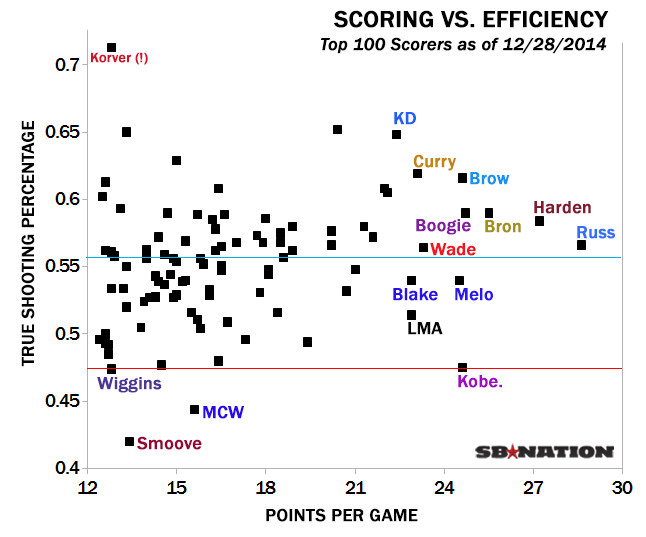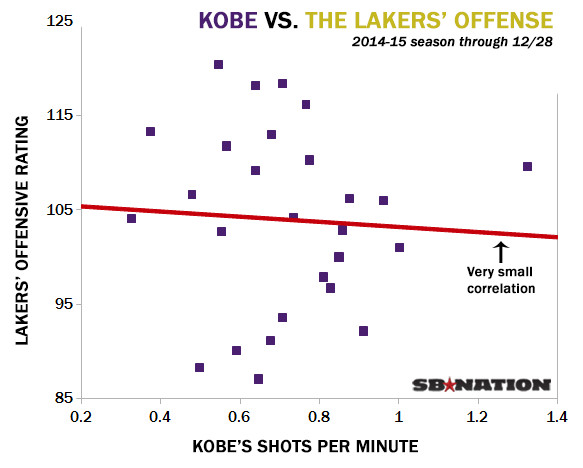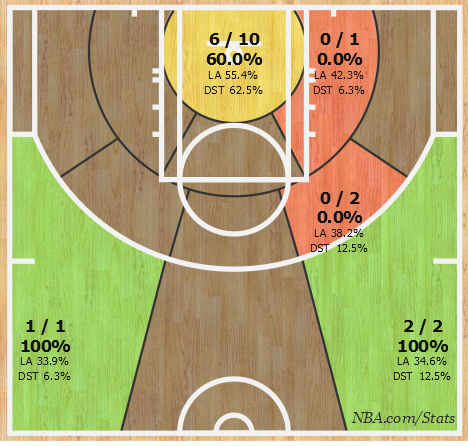- 85,813
- 112,236
- Joined
- Sep 5, 2010
http://www.sbnation.com/nba/2014/12/29/7456595/kobe-bryant-lakers-stats-shooting-hurting-mysteryWe don't actually know if Kobe Bryant is hurting the Lakers
Against all odds, Kobe Bryant is the single most interesting thing in the NBA this season. Not the return of the King, not the rise of fresh young powers, not even the Hawks can top Kobe in gawk-worthy expression.
And Kobe's mere existence has been raising voices all over the country in recent weeks. The culmination of that was ... well, that whole Christmas in Temecula thing. But there was also Byron Scott calling those who doubt Kobe's value "idiots." And along those lines, we have Michael Wilbon's piece on Kobe's fight against Father Time, a piece that included Wilbon calling analytic-minded folks who suggest Kobe is bringing down the Lakers "clowns."
The name-calling is over-the-top and is more becoming of the Mamba Army than an NBA head coach and a respected basketball writer, but the question stands. Are the Lakers better off without Kobe?
First, the case against Kobe: he is the least efficient high-scorer in the league. That matters.
The Lakers have an average offense, which is a minor miracle. Kobe is No. 5 in the NBA in points per game, but he takes a ridiculous number of shots to get there. Consider how much less efficient he is compared to his contemporaries.

Kobe is the least efficient player among the league's top 50 scorers. Only three players in the league's top 100 scorers are less efficient: Michael Carter-Williams (who went 2-20 over the weekend), Josh Smith (who got waived with tens of millions left on his deal last week) and, barely, Andrew Wiggins, a 19-year-old rookie.
Why does efficiency matter? Because teams don't get unlimited numbers of shots or possessions. The only way to win the game is to get more points out of your team's possessions than your opponent gets out of their possessions. They will have roughly the same number of possessions as you (give or take a couple due to end-of-quarter situations). If you end up with a lot of scoreless possessions, you either need to play good defense or you're going to lose. The Lakers have the No. 30 defense in the NBA, so winning that way's not happening.
But here's the thing: despite Kobe's undeniable inefficiency, he doesn't seem to be hurting the Lakers' offense in the aggregate.
As mentioned, the Lakers are average -- No. 15 as of Monday, to be exact -- in offensive efficiency. They are top-3 in turnover rate and in the top half of the league in free throw rate and offensive rebounding. The one offensive category in which the Lakers trail is, yes, shooting. And Kobe does take the bulk of shots. But when you look at the data, it's not obvious that all of those shots are hurting the offensive performance much.
Consider the fact that in games in which Kobe takes shots at a much lower frequency, the Lakers' offense isn't appreciably better.

The median for Kobe's shots per minute this season is 0.7. (As always, we're factoring in free throw trips.) In fact, when Kobe shoots more 0.7 shots per minute in a game, the Lakers' offense is slightly better than when he shoots less than 0.7 shots per minute.
There's more data to this effect. It's true that in the aggregate the Lakers have performed better offensively when Kobe is not on the floor, by about five points per 100 possessions. But raw on-off data is extremely noisy, as it doesn't at all account for the other nine players on the court or those replacing the players in question. That's why analytic types much prefer adjusted plus-minus. The best current public iteration for that is ESPN's Real Plus-Minus. In that measure, Kobe rates at +1.47 on offense.
In other words, once you account for the fact that Kobe is playing with lackluster teammates against primarily starters and that Kobe's replacements (including Nick Young) are playing more frequently against reserves, Bryant's on-court numbers don't look so bad. Or, more accurately, the Lakers' numbers when Kobe is on the floor don't look so bad. Kobe's numbers still look bad.
Young's individual numbers (especially shooting percentage) look much better than those of Kobe. But his real plus-minus offensive figure is +0.07. When you adjust for everything raw plus-minus doesn't account for, Kobe's impact doesn't look so bad.
How can Kobe be a credit to the Lakers' offense when he's the least efficient high-scorer in the entire league? Because shooting efficiency is just one part of the equation. I noted above that the Lakers rate highly in turnover rate. Kobe has a remarkably low turnover rate for someone who uses so many possessions. I noted that the Lakers get to the line a lot. Kobe is No. 2 on the team in free throw rate. There's also the matter of Kobe's passing, which is actually really good when he does it: he's No. 2 on the team in assist rate and is averaging almost five dimes per game. Kobe's poor shooting matters. But so does all of that.
The problem with the Lakers isn't offense. The problem with the Lakers is defense. Yes, Kobe is horrid on that end, but so is every other Laker not named Ed Davis at this point. The defense has been better when Young and Wayne Ellington play and in garbage time. Other than that, it's been a nightmare with and without Kobe. This should end up as Byron Scott's fourth consecutive bottom-5 defense.
(In fairness to the coach, he doesn't have defenders on his roster. In fairness to the roster -- and by extension GM Mitch Kupchak -- there's little evidence Scott would be able to squeeze a decent number out of it if he did have the players.)
Kobe is a part of the problem defensively, but if he weren't around, the Lakers would still be giving up way too many points. Despite Kobe's horrific shooting numbers, the data suggests the Lakers are better off on offense when he's on the court.
And that's the key here: the data suggests. We're certain about exactly nothing when it comes to the NBA, except perhaps that Zach Randolph is not to be toyed with and that Chris Bosh has a winning smile. Everything else is a mystery we can only bat around.
So there we are with Kobe Bean Bryant, who may or may not be hurting the Lakers by his very existence. The answer isn't obvious either way, so perhaps fewer visits to Temecula and more nuance during the debate is warranted.
Last edited:



 Such a Rondo thing to do.
Such a Rondo thing to do.










